Đề thi thử tốt nghiệp THPT năm 2021 môn Ngoại ngữ - Mã đề 401 (Có đáp án)
Read the following passage and mark the letter A, B, C, or D on your answer sheet to indicate the
correct word or phrase that best fits each of the numbered blanks .
Part of what makes summers so hot is also what causes thunderstorms. As heat from the sun beats
down on Earth, the heat evaporates some of the water in lakes and oceans. The evaporated water stays in
the air. This evaporated water makes the air feel heavy and humid. Humid air is what makes you feel hot
and sticky (1) _______ the summer.
Warm humid air usually does not stay in one place. The wind can move it higher in the sky (2) _______ it
will cool off. When warm humid air cools, it forms clouds. As more water is moved from lakes and
oceans to the airs, the clouds get bigger and bigger.
Since summer, the air near the ground is hotter than it is during other seasons of the year. When this hot
air mixes with cool air from (3) _______ area, there will be changes in the weather. Greater differnces
between the (4) _______ of the hot and cold air will cause greater changes in the weather. Imagine
putting an ice (5) _______ in a warm drink. As soon as the ice hits the warm drink, it will crack and pop.
But if you put the ice cube in a cool drink, it will not crack or pop as much. When warmer and cooler
clouds get close to one another, there may be some popping and cracking as the weather changes. There
may be more clouds or storms. A thunderstorm may be on its way.
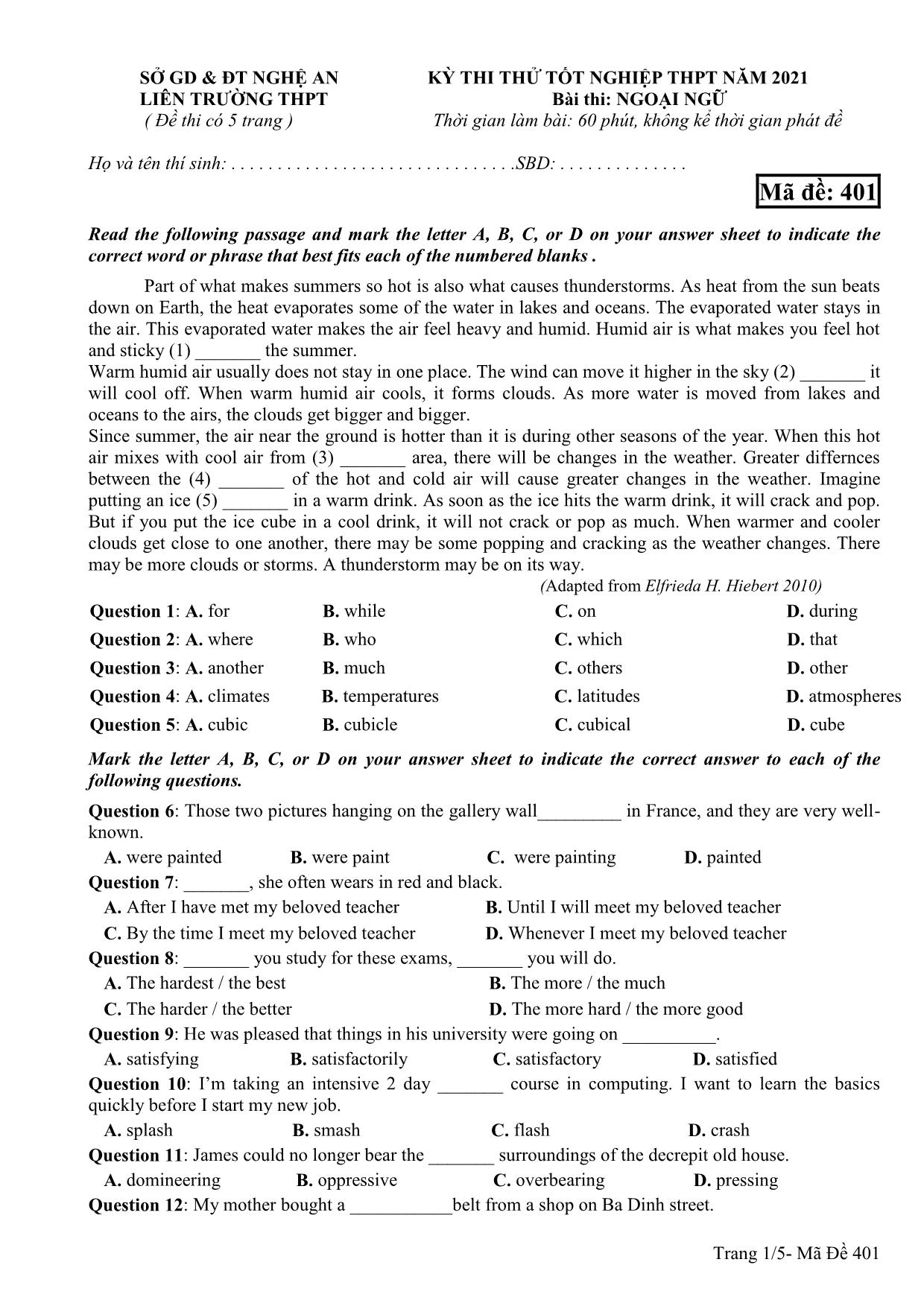
Trang 1
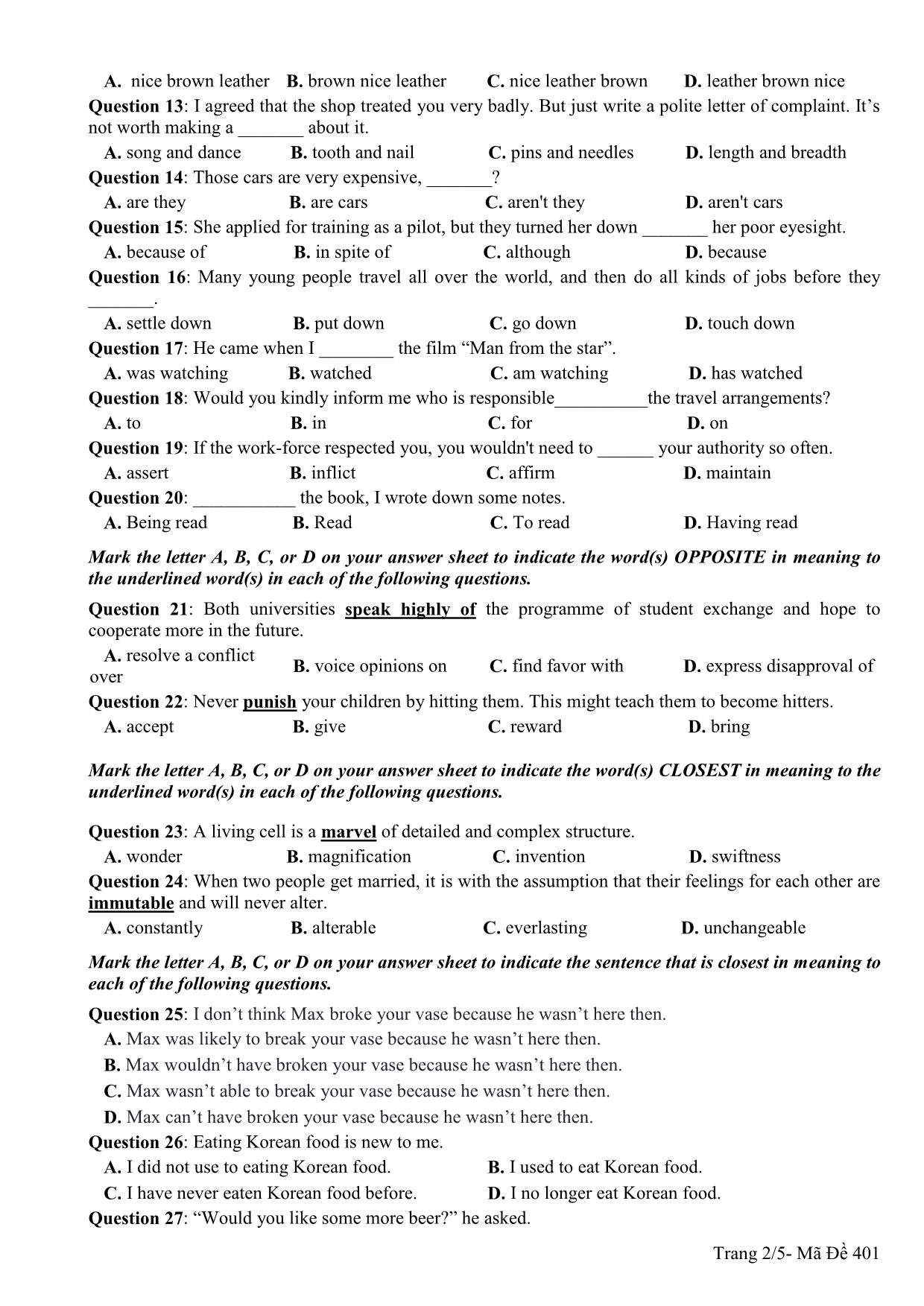
Trang 2
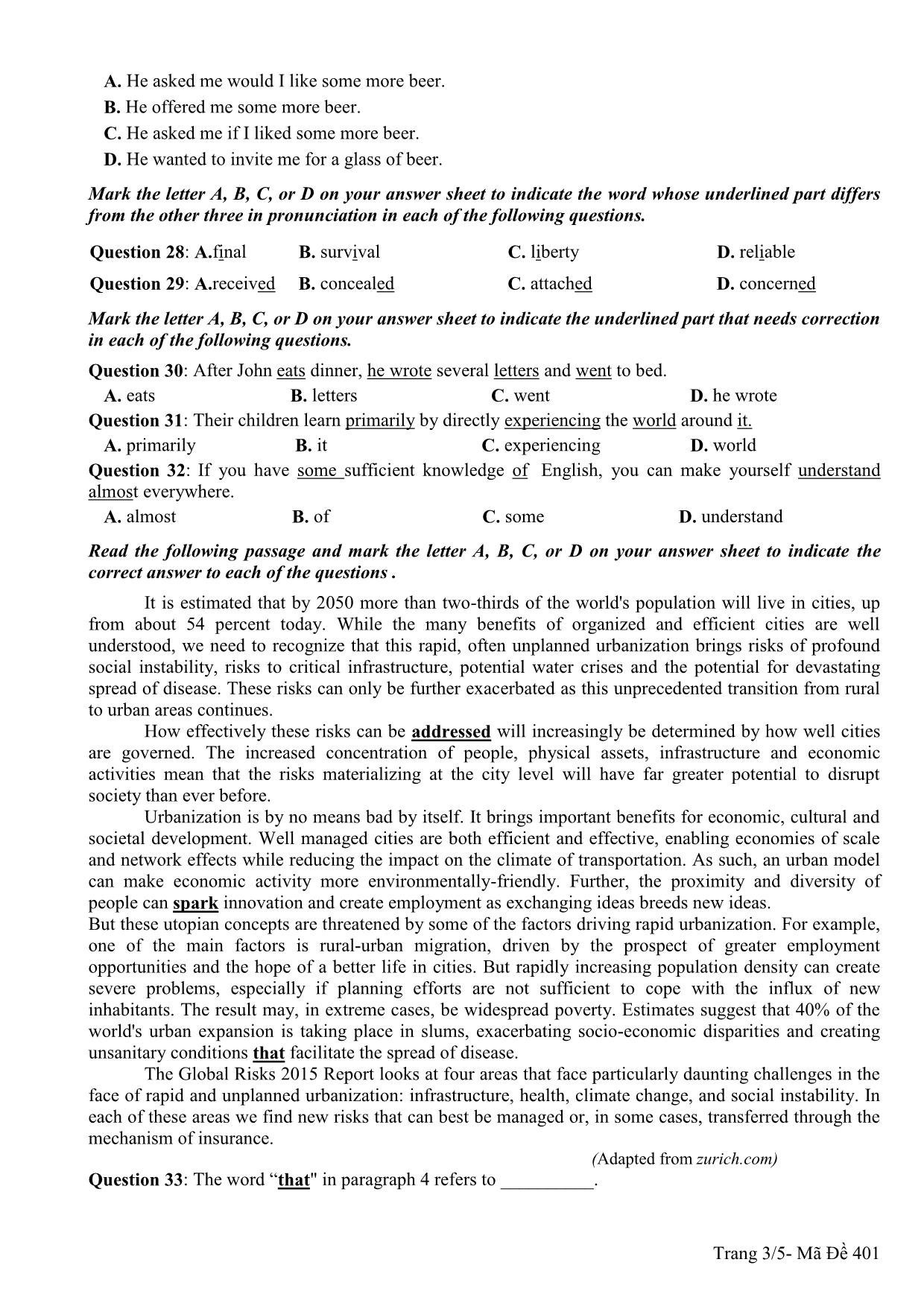
Trang 3
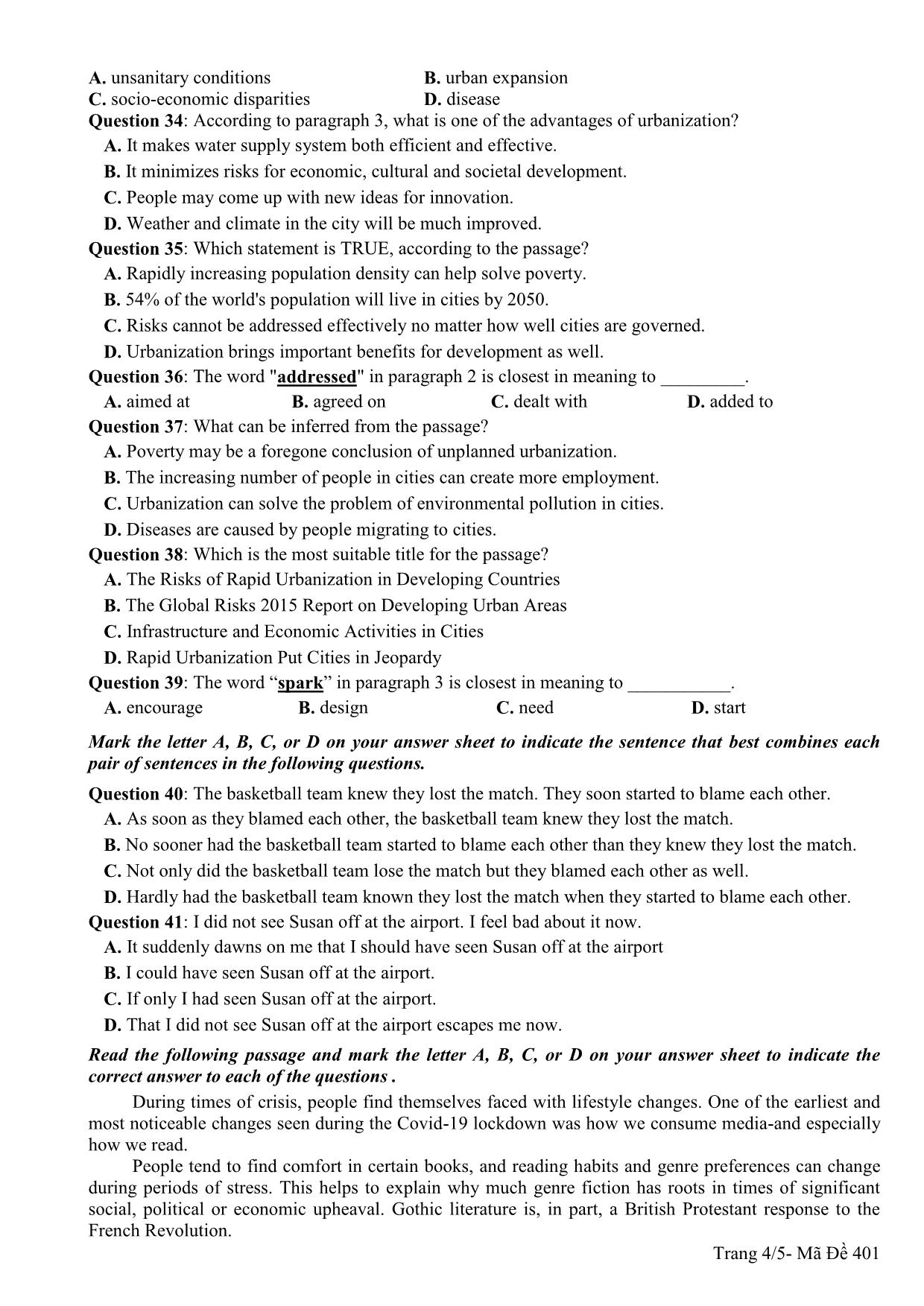
Trang 4
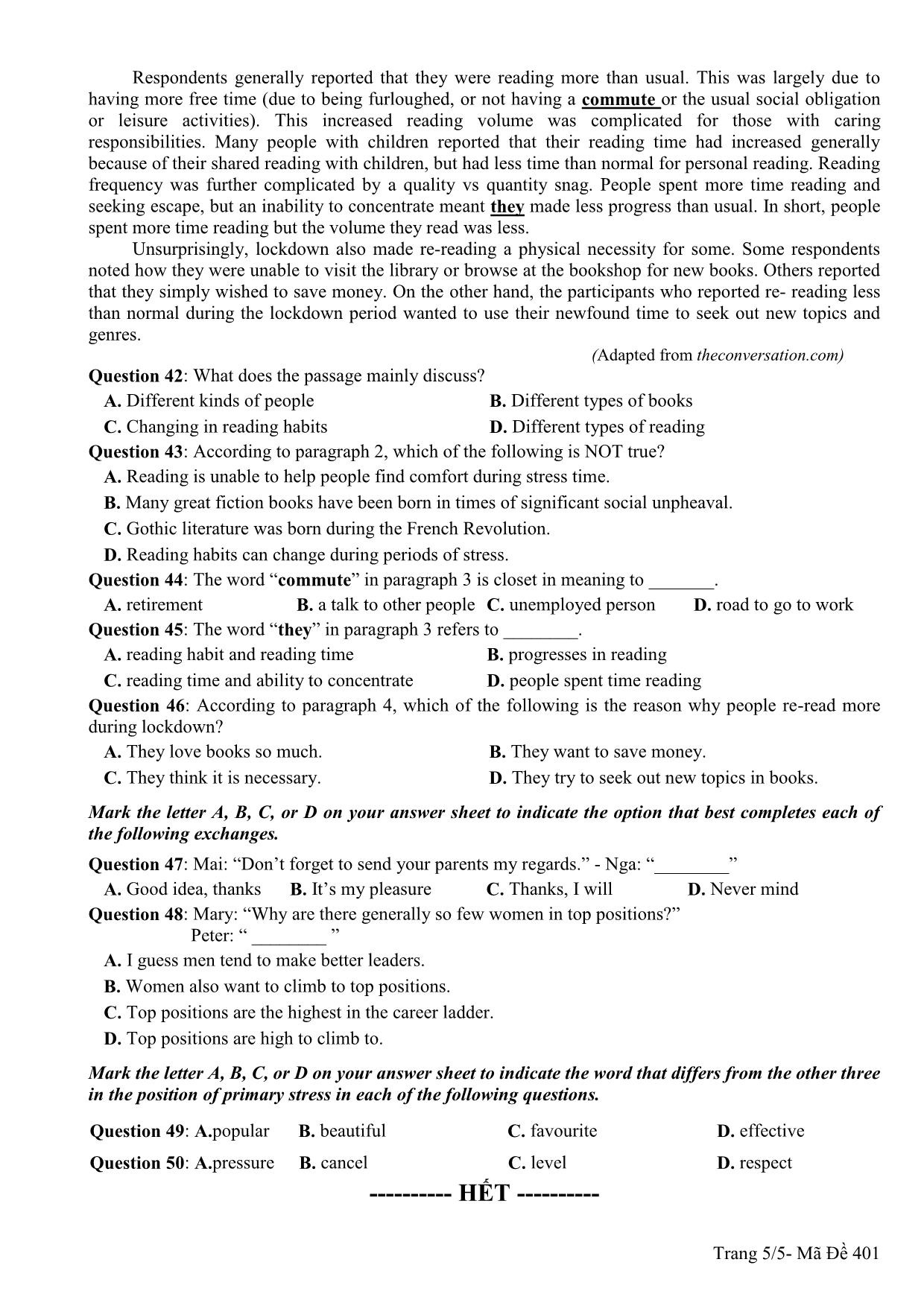
Trang 5
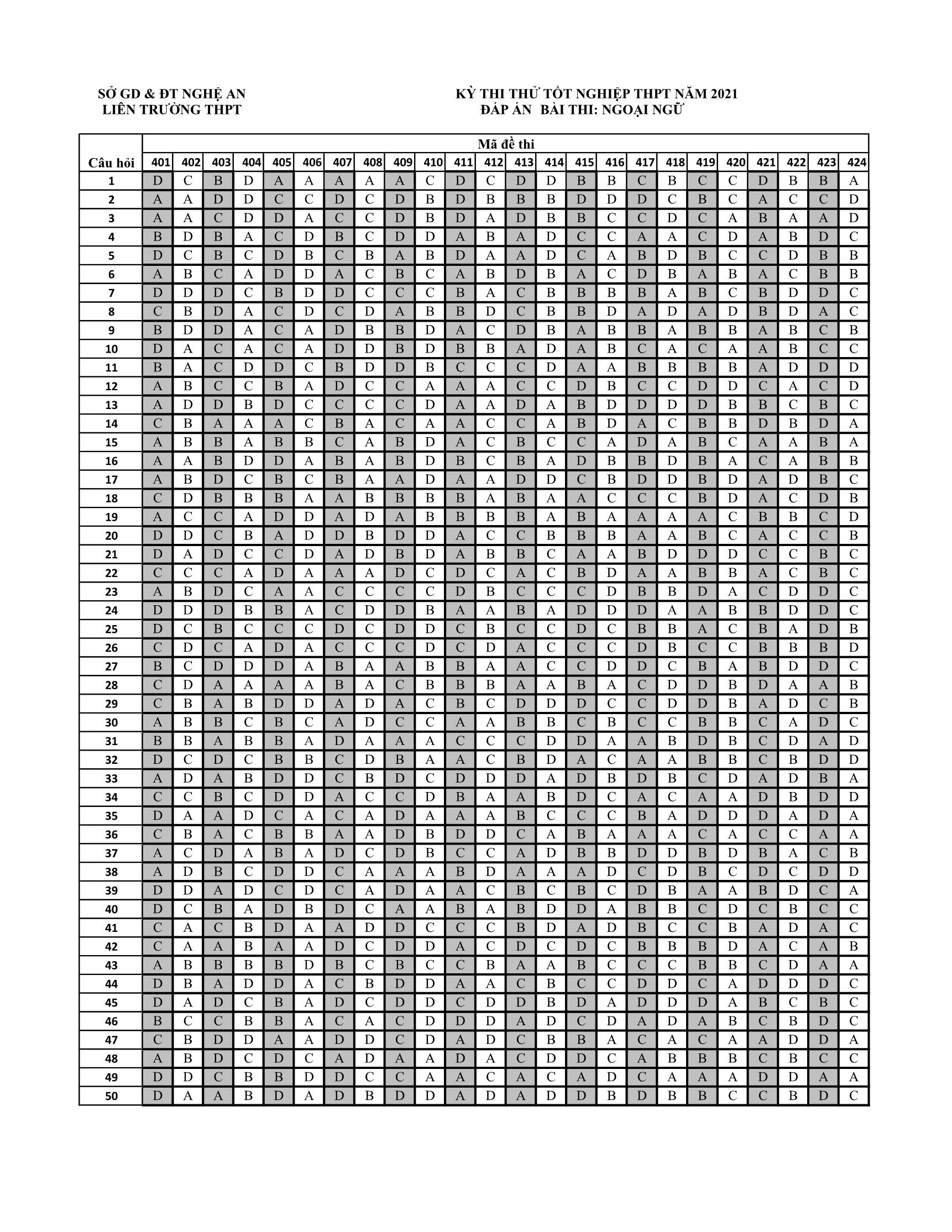
Trang 6
Tóm tắt nội dung tài liệu: Đề thi thử tốt nghiệp THPT năm 2021 môn Ngoại ngữ - Mã đề 401 (Có đáp án)
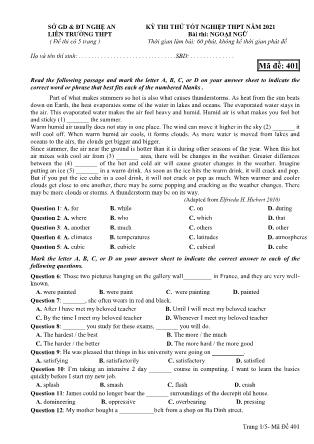
Trang 1/5- Mã Đề 401 SỞ GD & ĐT NGHỆ AN KỲ THI THỬ TỐT NGHIỆP THPT NĂM 2021 LIÊN TRƯỜNG THPT Bài thi: NGOẠI NGỮ ( Đề thi có 5 trang ) Thời gian làm bài: 60 phút, không kể thời gian phát đề Họ và tên thí sinh: . . . . . . . . . . . . . . . . . . . . . . . . . . . . . . .SBD: . . . . . . . . . . . . . . Mã đề: 401 Read the following passage and mark the letter A, B, C, or D on your answer sheet to indicate the correct word or phrase that best fits each of the numbered blanks . Part of what makes summers so hot is also what causes thunderstorms. As heat from the sun beats down on Earth, the heat evaporates some of the water in lakes and oceans. The evaporated water stays in the air. This evaporated water makes the air feel heavy and humid. Humid air is what makes you feel hot and sticky (1) _______ the summer. Warm humid air usually does not stay in one place. The wind can move it higher in the sky (2) _______ it will cool off. When warm humid air cools, it forms clouds. As more water is moved from lakes and oceans to the airs, the clouds get bigger and bigger. Since summer, the air near the ground is hotter than it is during other seasons of the year. When this hot air mixes with cool air from (3) _______ area, there will be changes in the weather. Greater differnces between the (4) _______ of the hot and cold air will cause greater changes in the weather. Imagine putting an ice (5) _______ in a warm drink. As soon as the ice hits the warm drink, it will crack and pop. But if you put the ice cube in a cool drink, it will not crack or pop as much. When warmer and cooler clouds get close to one another, there may be some popping and cracking as the weather changes. There may be more clouds or storms. A thunderstorm may be on its way. (Adapted from Elfrieda H. Hiebert 2010) Question 1: A. for B. while C. on D. during Question 2: A. where B. who C. which D. that Question 3: A. another B. much C. others D. other Question 4: A. climates B. temperatures C. latitudes D. atmospheres Question 5: A. cubic B. cubicle C. cubical D. cube Mark the letter A, B, C, or D on your answer sheet to indicate the correct answer to each of the following questions. Question 6: Those two pictures hanging on the gallery wall_________ in France, and they are very well- known. A. were painted B. were paint C. were painting D. painted Question 7: _______, she often wears in red and black. A. After I have met my beloved teacher B. Until I will meet my beloved teacher C. By the time I meet my beloved teacher D. Whenever I meet my beloved teacher Question 8: _______ you study for these exams, _______ you will do. A. The hardest / the best B. The more / the much C. The harder / the better D. The more hard / the more good Question 9: He was pleased that things in his university were going on __________. A. satisfying B. satisfactorily C. satisfactory D. satisfied Question 10: I’m taking an intensive 2 day _______ course in computing. I want to learn the basics quickly before I start my new job. A. splash B. smash C. flash D. crash Question 11: James could no longer bear the _______ surroundings of the decrepit old house. A. domineering B. oppressive C. overbearing D. pressing Question 12: My mother bought a ___________belt from a shop on Ba Dinh street. Trang 2/5- Mã Đề 401 A. nice brown leather B. brown nice leather C. nice leather brown D. leather brown nice Question 13: I agreed that the shop treated you very badly. But just write a polite letter of complaint. It’s not worth making a _______ about it. A. song and dance B. tooth and nail C. pins and needles D. length and breadth Question 14: Those cars are very expensive, _______? A. are they B. are cars C. aren't they D. aren't cars Question 15: She applied for training as a pilot, but they turned her down _______ her poor eyesight. A. because of B. in spite of C. although D. because Question 16: Many young people travel all over the world, and then do all kinds of jobs before they _______. A. settle down B. put down C. go down D. touch down Question 17: He came when I ________ the film “Man from the star”. A. was watching B. watched C. am watching D. has watched Question 18: Would you kindly inform me who is responsible__________the travel arrangements? A. to B. in C. for D. on Question 19: If the work-force respected you, you wouldn't need to ______ your authority so often. A. assert B. inflict C. affirm D. maintain Question 20: ___________ the book, I wrote down some notes. A. Being read B. Read C. To read D. Having read Mark the letter A, B, C, or D on your answer sheet to indicate the word(s) OPPOSITE in meaning to the underlined word(s) in each of the following questions. Question 21: Both universities speak highly of the programme of student exchange and hope to cooperate more in the future. A. resolve a conflict over B. voice opinions on C. find favor with D. express disapproval of Question 22: Never punish your children by hitting them. This might teach them to become hitters. A. accept B. give C. reward D. bring Mark the letter A, B, C, or D on your answer sheet to indicate the word(s) CLOSEST in meaning to the underlined word(s) in each of the following questions. Question 23: A living cell is a marvel of detailed and complex structure. A. wonder B. magnification C. invention D. swiftness Question 24: When two people get married, it is with the assumption that their feelings for each other are immutable and will never alter. A. constantly B. alterable C. everlasting D. unchangeable Mark the letter A, B, C, or D on your answer sheet to indicate the sentence that is closest in meaning to each of the following questions. Question 25: I don’t think Max broke your vase because he wasn’t here then. A. Max was likely to break your vase because he wasn’t here then. B. Max wouldn’t have broken your vase because he wasn’t here then. C. Max wasn’t able to break your vase because he wasn’t here then. D. Max can’t have broken your vase because he wasn’t here then. Question 26: Eating Korean food is new to me. A. I did not use to eating Korean food. B. I used to eat Korean food. C. I have never eaten Korean food before. D. I no longer eat Korean food. Question 27: “Would you like some more beer?” he asked. Trang 3/5- Mã Đề 401 A. He asked me would I like some more beer. B. He offered me some more beer. C. He asked me if I liked some more beer. D. He wanted to invite me for a glass of beer. Mark the letter A, B, C, or D on your answer sheet to indicate the word whose underlined part differs from the other three in pronunciation in each of the following questions. Question 28: A.final B. survival C. liberty D. reliable Question 29: A.received B. concealed C. attached D. concerned Mark the letter A, B, C, or D on your answer sheet to indicate the underlined part that needs correction in each of the following questions. Question 30: After John eats dinner, he wrote several letters and went to bed. A. eats B. letters C. went D. he wrote Question 31: Their children learn primarily by directly experiencing the world around it. A. primarily B. it C. experiencing D. world Question 32: If you have some sufficient knowledge of English, you can make yourself understand almost everywhere. A. almost B. of C. some D. understand Read the following passage and mark the letter A, B, C, or D on your answer sheet to indicate the correct answer to each of the questions . It is estimated that by 2050 more than two-thirds of the world's population will live in cities, up from about 54 percent today. While the many benefits of organized and efficient cities are well understood, we need to recognize that this rapid, often unplanned urbanization brings risks of profound social instability, risks to critical infrastructure, potential water crises and the potential for devastating spread of disease. These risks can only be further exacerbated as this unprecedented transition from rural to urban areas continues. How effectively these risks can be addressed will increasingly be determined by how well cities are governed. The increased concentration of people, physical assets, infrastructure and economic activities mean that the risks materializing at the city level will have far greater potential to disrupt society than ever before. Urbanization is by no means bad by itself. It brings important benefits for economic, cultural and societal development. Well managed cities are both efficient and effective, enabling economies of scale and network effects while reducing the impact on the climate of transportation. As such, an urban model can make economic activity more environmentally-friendly. Further, the proximity and diversity of people can spark innovation and create employment as exchanging ideas breeds new ideas. But these utopian concepts are threatened by some of the factors driving rapid urbanization. For example, one of the main factors is rural-urban migration, driven by the prospect of greater employment opportunities and the hope of a better life in cities. But rapidly increasing population density can create severe problems, especially if planning efforts are not sufficient to cope with the influx of new inhabitants. The result may, in extreme cases, be widespread poverty. Estimates suggest that 40% of the world's urban expansion is taking place in slums, exacerbating socio-economic disparities and creating unsanitary conditions that facilitate the spread of disease. The Global Risks 2015 Report looks at four areas that face particularly daunting challenges in the face of rapid and unplanned urbanization: infrastructure, health, climate change, and social instability. In each of these areas we find new risks that can best be managed or, in some cases, transferred through the mechanism of insurance. (Adapted from zurich.com) Question 33: The word “that" in paragraph 4 refers to __________. Trang 4/5- Mã Đề 401 A. unsanitary conditions B. urban expansion C. socio-economic disparities D. disease Question 34: According to paragraph 3, what is one of the advantages of urbanization? A. It makes water supply system both efficient and effective. B. It minimizes risks for economic, cultural and societal development. C. People may come up with new ideas for innovation. D. Weather and climate in the city will be much improved. Question 35: Which statement is TRUE, according to the passage? A. Rapidly increasing population density can help solve poverty. B. 54% of the world's population will live in cities by 2050. C. Risks cannot be addressed effectively no matter how well cities are governed. D. Urbanization brings important benefits for development as well. Question 36: The word "addressed" in paragraph 2 is closest in meaning to _________. A. aimed at B. agreed on C. dealt with D. added to Question 37: What can be inferred from the passage? A. Poverty may be a foregone conclusion of unplanned urbanization. B. The increasing number of people in cities can create more employment. C. Urbanization can solve the problem of environmental pollution in cities. D. Diseases are caused by people migrating to cities. Question 38: Which is the most suitable title for the passage? A. The Risks of Rapid Urbanization in Developing Countries B. The Global Risks 2015 Report on Developing Urban Areas C. Infrastructure and Economic Activities in Cities D. Rapid Urbanization Put Cities in Jeopardy Question 39: The word “spark” in paragraph 3 is closest in meaning to ___________. A. encourage B. design C. need D. start Mark the letter A, B, C, or D on your answer sheet to indicate the sentence that best combines each pair of sentences in the following questions. Question 40: The basketball team knew they lost the match. They soon started to blame each other. A. As soon as they blamed each other, the basketball team knew they lost the match. B. No sooner had the basketball team started to blame each other than they knew they lost the match. C. Not only did the basketball team lose the match but they blamed each other as well. D. Hardly had the basketball team known they lost the match when they started to blame each other. Question 41: I did not see Susan off at the airport. I feel bad about it now. A. It suddenly dawns on me that I should have seen Susan off at the airport B. I could have seen Susan off at the airport. C. If only I had seen Susan off at the airport. D. That I did not see Susan off at the airport escapes me now. Read the following passage and mark the letter A, B, C, or D on your answer sheet to indicate the correct answer to each of the questions . During times of crisis, people find themselves faced with lifestyle changes. One of the earliest and most noticeable changes seen during the Covid-19 lockdown was how we consume media-and especially how we read. People tend to find comfort in certain books, and reading habits and genre preferences can change during periods of stress. This helps to explain why much genre fiction has roots in times of significant social, political or economic upheaval. Gothic literature is, in part, a British Protestant response to the French Revolution. Trang 5/5- Mã Đề 401 Respondents generally reported that they were reading more than usual. This was largely due to having more free time (due to being furloughed, or not having a commute or the usual social obligation or leisure activities). This increased reading volume was complicated for those with caring responsibilities. Many people with children reported that their reading time had increased generally because of their shared reading with children, but had less time than normal for personal reading. Reading frequency was further complicated by a quality vs quantity snag. People spent more time reading and seeking escape, but an inability to concentrate meant they made less progress than usual. In short, people spent more time reading but the volume they read was less. Unsurprisingly, lockdown also made re-reading a physical necessity for some. Some respondents noted how they were unable to visit the library or browse at the bookshop for new books. Others reported that they simply wished to save money. On the other hand, the participants who reported re- reading less than normal during the lockdown period wanted to use their newfound time to seek out new topics and genres. (Adapted from theconversation.com) Question 42: What does the passage mainly discuss? A. Different kinds of people B. Different types of books C. Changing in reading habits D. Different types of reading Question 43: According to paragraph 2, which of the following is NOT true? A. Reading is unable to help people find comfort during stress time. B. Many great fiction books have been born in times of significant social unpheaval. C. Gothic literature was born during the French Revolution. D. Reading habits can change during periods of stress. Question 44: The word “commute” in paragraph 3 is closet in meaning to _______. A. retirement B. a talk to other people C. unemployed person D. road to go to work Question 45: The word “they” in paragraph 3 refers to ________. A. reading habit and reading time B. progresses in reading C. reading time and ability to concentrate D. people spent time reading Question 46: According to paragraph 4, which of the following is the reason why people re-read more during lockdown? A. They love books so much. B. They want to save money. C. They think it is necessary. D. They try to seek out new topics in books. Mark the letter A, B, C, or D on your answer sheet to indicate the option that best completes each of the following exchanges. Question 47: Mai: “Don’t forget to send your parents my regards.” - Nga: “________” A. Good idea, thanks B. It’s my pleasure C. Thanks, I will D. Never mind Question 48: Mary: “Why are there generally so few women in top positions?” Peter: “ ________ ” A. I guess men tend to make better leaders. B. Women also want to climb to top positions. C. Top positions are the highest in the career ladder. D. Top positions are high to climb to. Mark the letter A, B, C, or D on your answer sheet to indicate the word that differs from the other three in the position of primary stress in each of the following questions. Question 49: A.popular B. beautiful C. favourite D. effective Question 50: A.pressure B. cancel C. level D. respect ---------- HẾT ---------- 401 402 403 404 405 406 407 408 409 410 411 412 413 414 415 416 417 418 419 420 421 422 423 424 1 D C B D A A A A A C D C D D B B C B C C D B B A 2 A A D D C C D C D B D B B B D D D C B C A C C D 3 A A C D D A C C D B D A D B B C C D C A B A A D 4 B D B A C D B C D D A B A D C C A A C D A B D C 5 D C B C D B C B A B D A A D C A B D B C C D B B 6 A B C A D D A C B C A B D B A C D B A B A C B B 7 D D D C B D D C C C B A C B B B B A B C B D D C 8 C B D A C D C D A B B D C B B D A D A D B D A C 9 B D D A C A D B B D A C D B A B B A B B A B C B 10 D A C A C A D D B D B B A D A B C A C A A B C C 11 B A C D D C B D D B C C C D A A B B B B A D D D 12 A B C C B A D C C A A A C C D B C C D D C A C D 13 A D D B D C C C C D A A D A B D D D D B B C B C 14 C B A A A C B A C A A C C A B D A C B B D B D A 15 A B B A B B C A B D A C B C C A D A B C A A B A 16 A A B D D A B A B D B C B A D B B D B A C A B B 17 A B D C B C B A A D A A D D C B D D B D A D B C 18 C D B B B A A B B B B A B A A C C C B D A C D B 19 A C C A D D A D A B B B B A B A A A A C B B C D 20 D D C B A D D B D D A C C B B B A A B C A C C B 21 D A D C C D A D B D A B B C A A B D D D C C B C 22 C C C A D A A A D C D C A C B D A A B B A C B C 23 A B D C A A C C C C D B C C C D B B D A C D D C 24 D D D B B A C D D B A A B A D D D A A B B D D C 25 D C B C C C D C D D C B C C D C B B A C B A D B 26 C D C A D A C C C D C D A C C C D B C C B B B D 27 B C D D D A B A A B B A A C C D D C B A B D D C 28 C D A A A A B A C B B B A A B A C D D B D A A B 29 C B A B D D A D A C B C D D D C C D D B A D C B 30 A B B C B C A D C C A A B B C B C C B B C A D C 31 B B A B B A D A A A C C C D D A A B D B C D A D 32 D C D C B B C D B A A C B D A C A A B B C B D D 33 A D A B D D C B D C D D D A D B D B C D A D B A 34 C C B C D D A C C D B A A B D C A C A A D B D D 35 D A A D C A C A D A A A B C C C B A D D D A D A 36 C B A C B B A A D B D D C A B A A A C A C C A A 37 A C D A B A D C D B C C A D B B D D B D B A C B 38 A D B C D D C A A A B D A A A D C D B C D C D D 39 D D A D C D C A D A A C B C B C D B A A B D C A 40 D C B A D B D C A A B A B D D A B B C D C B C C 41 C A C B D A A D D C C C B D A D B C C B A D A C 42 C A A B A A D C D D A C D C D C B B B D A C A B 43 A B B B B D B C B C C B A A B C C C B B C D A A 44 D B A D D A C B D D A A C B C C D D C A D D D C 45 D A D C B A D C D D C D D B D A D D D A B C B C 46 B C C B B A C A C D D D A D C D A D A B C B D C 47 C B D D A A D D C D A D C B B A C A C A A D D A 48 A B D C D C A D A A D A C D D C A B B B C B C C 49 D D C B B D D C C A A C A C A D C A A A D D A A 50 D A A B D A D B D D A D A D D B D B B C C B D C Câu hỏi Mã đề thi SỞ GD & ĐT NGHỆ AN KỲ THI THỬ TỐT NGHIỆP THPT NĂM 2021 LIÊN TRƯỜNG THPT ĐÁP ÁN BÀI THI: NGOẠI NGỮ
File đính kèm:
 de_thi_thu_tot_nghiep_thpt_nam_2021_mon_ngoai_ngu_ma_de_401.pdf
de_thi_thu_tot_nghiep_thpt_nam_2021_mon_ngoai_ngu_ma_de_401.pdf

